Invasive species
A number of millipede species are known to have been introduced to Tasmania. Introduced Polydesmida are linked to this page from the Polydesmida key and are further described below. Introduced Julida were identified as a group on the "juliforms" page and are keyed out below.
POLYDESMIDA
Akamptogonus novarae (Humbert and de Saussure, 1869)
Akamptogonus novarae grows to ca 20 mm long. It was first collected from a Launceston garden in the 1970s, and in the 2000s it was found in the Royal Tasmanian Botanical Gardens in Hobart and in parkland at Riverside in Launceston. At Upper Scamander it was found in 2023 on a farm and in nearby native forest. A. novarae is believed to be native to the Australian mainland (probably NSW), but its home range is unknown. Overseas, it has been recorded in New Zealand, the Hawaiian Islands and California (USA), and Mexico.
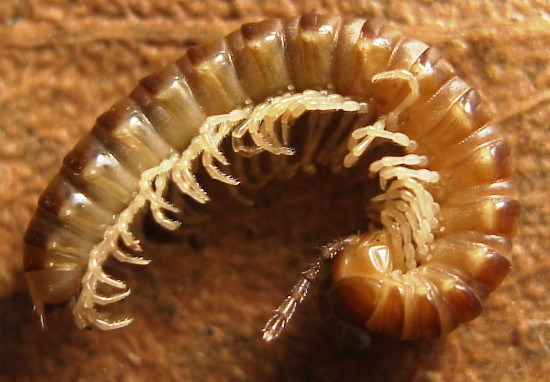

Brachydesmus superus Latzel, 1884
This introduced species is 8-10 mm long and white or pale brown in colour. Brachydesmus superus is widely distributed in Europe and has been introduced into a number of other temperate areas. It has apparently been in Tasmania for many years. An agricultural pest guide published in 1943 reported that The Flat Brown Millipede, which ... frequently occurs in company with the White Millipede [Blaniulus guttulatus], is found all over the State. Overseas, B. superus has been reported to attack some crops. In Tasmania, local populations of this species can be very large, and I have seen dense B. superus colonies in garden mulch in parks around Tasmania.
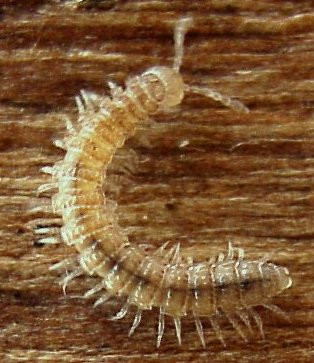
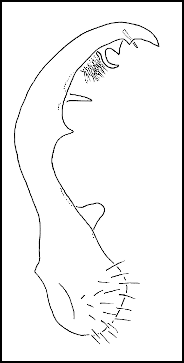
Gonopod drawing by Sergei Golovatch
Taxidiotisoma portabile Mesibov and Car, 2015
Like Akamptogonus novarae, this species is a "native exotic" Australian. Its home range is believed to be in south coastal New South Wales. Taxidiotisoma portabile has been found in cities, towns and long-farmed areas in New South Wales and Victoria. So far its only known Tasmanian locality is Perth.
Adult T. portabile are ca 20 mm long and handsomely coloured, with a reddish brown body and yellow legs.
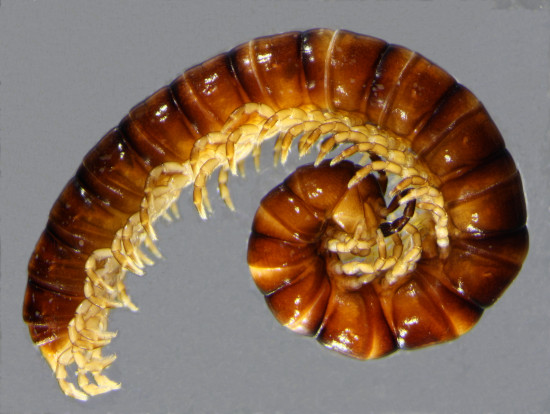
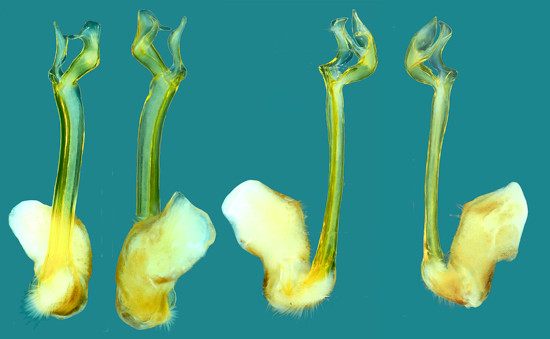
Gonopod images by Catherine Car
JULIDA
|
1a. Long, pointed projection on "tail" (left-hand image)
|
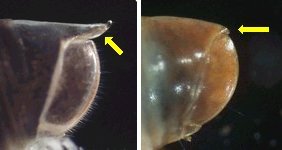 |
|
2a. Projection on "tail" curved upwards; no obvious bristles (setae) on posterior fringe of segments (left-hand image)
|
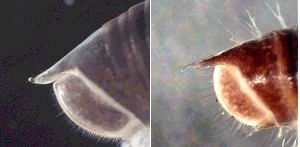 |
Ommatoiulus moreleti (Lucas, 1860)
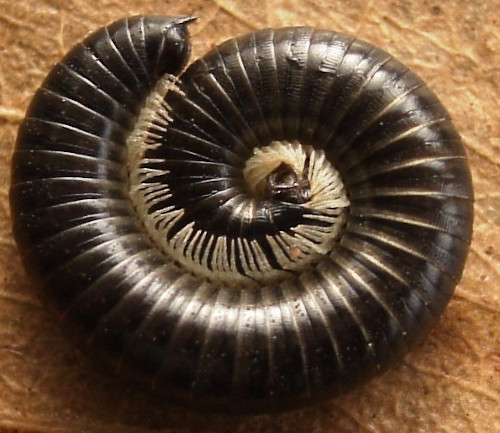
Ommatoiulus moreleti is a stout, black species to 40 mm long. It is native to the Iberian Peninsula and is known in Australia as the "Portugese Millipede" or "Black Portugese Millipede". In Adelaide it has been a household pest since the 1970s, and west of Melbourne it has stopped trains by swarming over the rail lines. As with many introduced species, the boom in O. moreleti populations in particular areas has been followed several years later by a crash to much lower numbers.
Mass appearances of this species are usual in autumn (and sometimes in spring) in Hobart, Launceston, Burnie and Devonport. In all of these places O. moreleti enters houses, which is not surprising: Portugese millipede populations in some backyards are of the order of 1000 - 5000 individuals. In some long-farmed parts of Tasmania, O. moreleti has invaded the bush and is now the dominant millipede species, e.g. near Conara. It has been present in the State at least since the mid-1970s.
Ophyiulus species
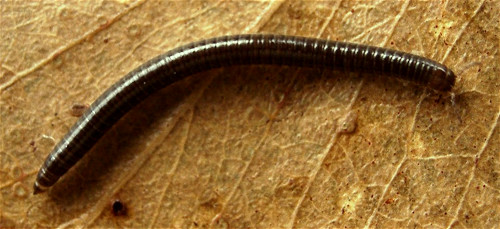
There are probably two different Ophyiulus species in Tasmania: O. pilosus (Newport, 1843) and O. targionii Silvestri, 1898. In Tasmanian backyards Ophyiulus is often extremely abundant. Householders know it as a thin black millipede up to 30 mm long that wriggles vigorously when disturbed, rather than coiling in a flat spiral. It has been reported entering houses in several localities. Like Cylindroiulus, Ophyiulus has successfully invaded Tasmanian bushland, but to my knowledge only after serious disturbance (clearfelling, frequent burning, weed infestation).
|
3a. Eyes absent (see image at right); body pale with red spots on sides (specimens in alcohol may be uniformly reddish)
|
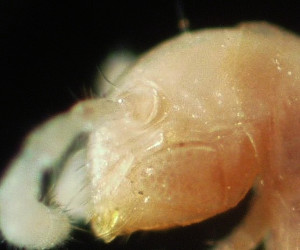 |
Blaniulus guttulatus (Fabricius, 1798)
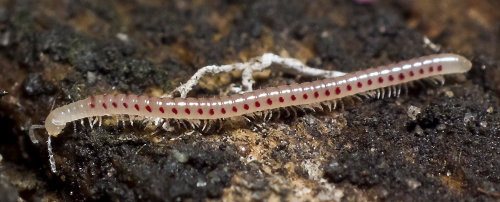
Image by Tony Daley
Blaniulus guttulatus reaches ca 12 mm in length. Like some specimens of Cylindroiulus species it has large pink or red spots along its sides when alive, but it can be distinguished from Cylindroiulus by its lack of eyes. It rapidly curls in a tight, flat spiral when disturbed.
This species seems to have been more widespread and abundant in Tasmania in the past than it is now, but it can still be found in gardens (and in a cave at Gunns Plains). Overseas, B. guttulatus has been found burrowing into tubers, bulbs, and rotting, fallen fruit. It has also been reported to attack seedlings, e.g. peas in commercial crops. Because B. guttulatus is a farm and garden pest in many temperate countries (its country of origin is uncertain), there is a large print and Web literature on its biology and control.
|
4a. Eyes in line behind antenna (left-hand image); body light brown
|
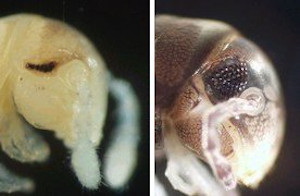 |
Choneiulus palmatus (Nĕmec, 1895)
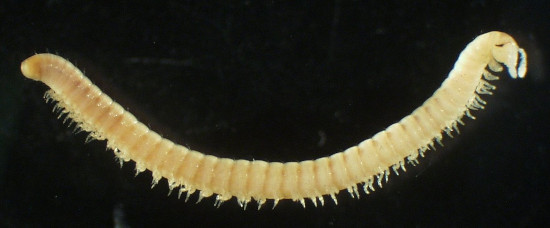
Choneiulus palmatus has 14-20 prominent bristles (setae) along the rear edge of each segment. It is so far known in Tasmania from a few specimens at a farm at Gunns Plains and a Pinus radiata plantation at Stoodley. Growing to 15 mm in length, C. palmatus is native to Europe and the Tasmanian records are apparently the first for Australia. I am grateful to Helen Read (Farnham Common, UK) and Henrik Enghoff (Zoological Museum, Copenhagen) for identifying this species.
|
5a. Older individuals usually less than 12 mm long, with two light-coloured stripes on either side of darker mid-dorsal line
|
Brachyiulus pusillus (Leach, 1815)

This small (to ca 13 mm long) and distinctively marked millipede occurs across most of Europe and has been introduced into many other places around the world. It has scattered occurrences in settled areas throughout Tasmania.
Cylindroiulus species
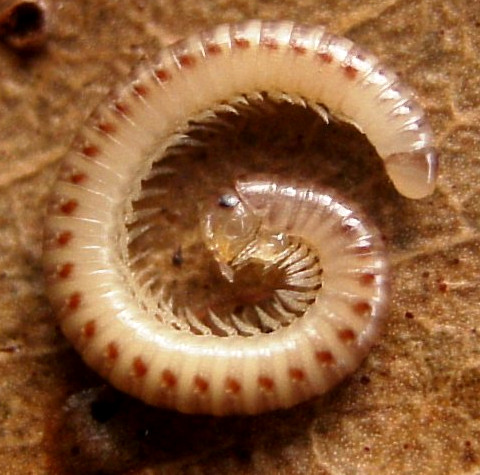
There are at least three Cylindroiulus species in Tasmania, all originally from Europe. Two of the Tasmanian invasives have been identified as C. brittanicus (Verhoeff, 1891) and C. latestriatus (Curtis, 1845). Colouring is variable and many individuals are darker than the one shown above. In Tasmania Cylindroiulus species are not confined to farms and gardens and are invading partly disturbed habitats in the north, west and centre of the State, e.g. at Pumphouse Point at Lake St Clair.
